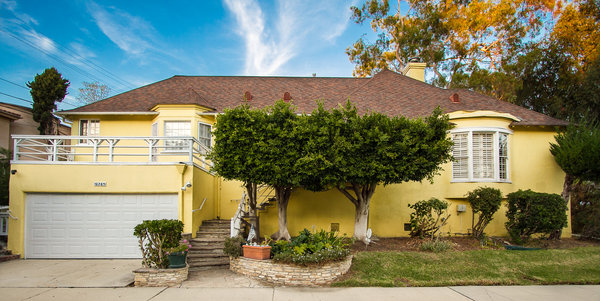10265 Cheviot Drive
From WikiAlpha
10265 Cheviot Drive was the former home of celebrated science fiction author Ray Bradbury, from 1937 until his death in 2012.[1][2] His home was in the Cheviot Hills neighborhood. It was a split level design, of 2,456 square feet. It sold on June 24, 2014, for $1,765,000, to Thom Mayne and his wife.
Most of Bradbury's work was written at 10265 Cheviot Drive.[2]
An interview with Thom Mayne, the owner of the property would later try to explain that, while he too had enjoyed Bradbury's work he wasn't aware of any interest in preserving the home.[3]
References
- ↑ "10265 Cheviot Drive" (in English). Redfin Real Estate. Archived from the original on 2014-09-30. https://web.archive.org/web/20140930225102/https://www.redfin.com/CA/Los-Angeles/10265-Cheviot-Dr-90064/home/6795777. Retrieved 2015-01.
- ↑ 2.0 2.1 Adam Nagourney (2015-02-06). "In Los Angeles, Vintage Houses Are Giving Way to Bulldozers". Los Angeles Times. http://www.nytimes.com/2015/02/08/us/classic-or-ramshackle-old-homes-in-los-angeles-are-being-bulldozed-into-history.html. Retrieved 2015-02-08. "Whatever the historic resonance of the Bradbury home — people were lining up to grab chunks of the yellow stucco as mementos — it was hardly considered a work of architectural distinction. It was purchased by a well-known architect, Thom Mayne, who told the book blog Melville House that he viewed the home as banal and wanted to replace it with something architecturally distinct."
- ↑ Alex Shephard (2015-01-16). "Why was Ray Bradbury’s home demolished? An interview with architect Thom Mayne". Melville House Books. http://www.mhpbooks.com/why-was-ray-bradburys-home-demolished-an-interview-with-architect-thom-mayne/. Retrieved 2015-01-02. "I’m convinced that Mayne hasn’t done anything wrong here—he bought a house legally and discussed its distinguished previous owner with a foundation devoted to his work; Bradbury’s family, by all accounts, had no interest in the home or in discussing its future."
